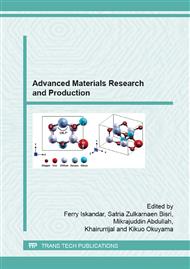[1]
H. -C. Moeller, M. K. Mian, S. Shrivastava, B. G. Chung, and A. Khademhosseini, A microwell array system for stem cell culture, Biomaterials, . 9(6), (2008) 752-763.
DOI: 10.1016/j.biomaterials.2007.10.030
Google Scholar
[2]
T. G. van Kooten, H. T. Spijker, and H. J. Busscher, Plasma-treated polystyrene surfaces: model surfaces for studying cell–biomaterial interactions, Biomaterials. 25 (2004) 1735-1747.
DOI: 10.1016/j.biomaterials.2003.08.071
Google Scholar
[3]
Z. Shourgashti, M. T. Khorasani, and S. M. E. Khosroshahi, Plasma-induced grafting of polydimethylsiloxane onto polyurethane surface: Characterization and in vitro assay, "Radiation Physics and Chemistry. 79 (2010) 947-952.
DOI: 10.1016/j.radphyschem.2010.04.007
Google Scholar
[4]
H. -H. Shuai, C. -Y. Yang, H. I. C. Harn, R. L. York, T. -C. Liao, W. -S. Chen, et al., Using surfaces to modulate the morphology and structure of attached cells - a case of cancer cells on chitosan membranes, Chemical Science. 4 (2013) 3058-3067.
DOI: 10.1039/c3sc50533b
Google Scholar
[5]
M. Ni, W. H. Tong, D. Choudhury, N. A. A. Rahim, C. Iliescu, and H. Yu, Cell culture on MEMS platforms: A review, International journal of molecular sciences. 10 (2009) 5411-5441.
DOI: 10.3390/ijms10125411
Google Scholar
[6]
S. Selimovic, F. Piraino, H. Bae, M. Rasponi, A. Redaelli, and A. Khademhosseini, Microfabricated polyester conical microwells for cell culture applications, Lab on a Chip. 11 (2011) 2325-2332.
DOI: 10.1039/c1lc20213h
Google Scholar
[7]
Y. Guan and W. Kisaalita, Cell adhesion and locomotion on microwell-structured glass substrates, Colloids and Surfaces B: Biointerfaces. 84 (2011) 35-43.
DOI: 10.1016/j.colsurfb.2010.12.007
Google Scholar
[8]
G. Altankov, F. Grinnell, and T. Groth, Studies on the biocompatibility of materials: Fibroblast reorganization of substratum-bound fibronectin on surfaces varying in wettability, Journal of Biomedical Materials Research. 30 (1996) 385-391.
DOI: 10.1002/(sici)1097-4636(199603)30:3<385::aid-jbm13>3.0.co;2-j
Google Scholar
[9]
R. Derda, S. K. Y. Tang, A. Laromaine, B. Mosadegh, E. Hong, M. Mwangi, et al., Multizone Paper Platform for 3D Cell Cultures, PLoS ONE. 6 (2011) e18940.
DOI: 10.1371/journal.pone.0018940
Google Scholar
[10]
C. -I. Su, J. -X. Fang, X. -H. Chen, and W. -Y. Wu, Moisture absorption and release of profiled polyester and cotton composite knitted fabrics, Textile research journal. 77 (2007) 764-769.
DOI: 10.1177/0040517507080696
Google Scholar
[11]
K. -H. Kim, J. -S. Cho, D. -J. Choi, and S. -K. Koh, Hydrophilic group formation and cell culturing on polystyrene Petri-dish modified by ion-assisted reaction, Nuclear Instruments and Methods in Physics Research Section B: Beam Interactions with Materials and Atoms. 175–177 (2001).
DOI: 10.1016/s0168-583x(00)00650-9
Google Scholar
[12]
D. P. Dowling, I. S. Miller, M. Ardhaoui, and W. M. Gallagher, Effect of surface wettability and topography on the adhesion of osteosarcoma cells on plasma-modified polystyrene, J Biomater Appl. 26 (2011) 327-47.
DOI: 10.1177/0885328210372148
Google Scholar
[13]
J. Y. Lim, J. C. Hansen, C. A. Siedlecki, R. W. Hengstebeck, J. Cheng, N. Winograd, et al., Osteoblast adhesion on poly(L-lactic acid)/polystyrene demixed thin film blends: effect of nanotopography, surface chemistry, and wettability, Biomacromolecules. 6 (2005).
DOI: 10.1021/bm0503423
Google Scholar


